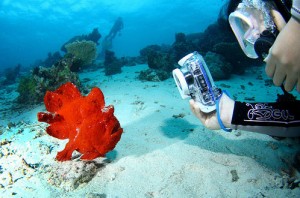

Underwater Photography
Underwater photography can be a real fun for scuba diver. There are so many amazing scenes to be shot included (but not limited to) colorful marine animals, coral reefs, sharks and it seems that they are shouting “Photograph Us”. Like many other persons, I was fan of Jacques Cousteau specials too and scuba diving was always in my “Things to Do” list. When I tried it first time, I was completely stunned with its beauty and it’s like an addiction you always want more. So I decided that next time my digital camera will not be left at home alone.
If you have paid attention to underwater photography in past, you may noticed that there are 2 types of underwater photographs, wide-angle (main subject in the foreground) and macro (close-up). The reason is that in underwater environment water is not clear at all even if it seems that it is crystal clear, thus it’s quite difficult to shot subject which are located far from camera. Another very important factor is that ray of light which is passing thru water is being partially adsorbed especially warm colors (red and yellow). That is why in depth of 50feet all around will be presented in blue/green; same is true if subject is 50 feet away from camera. Thus one of the most important actions is: Eliminate the distance between subject and camera. With use of wide angle lenses it’s possible to have very close focus on large objects not losing environment view around it. Macro shots are working well if you’re quite close the subject which might be shot. There is no sense to take Telephoto lenses as they are completely useless underwater.
Most of professional photographers who are making their photos on the ground (I mean outside of water) would agree that it’s possible to get decent results with Point and Shoot or cheap SLR camera under the certain conditions, but same is no true for underwater photography. It’s almost impossible to get good images using cheap SLR or P&S devices in underwater. And it’s not because that making underwater photos are harder, but plus you always should consider the fact that in water there are many specific optical problems, which should be always considered. Thus cheap products ( such as Bonica, Snapper, ikelite, Aquashot, some Sea & Sea cameras and ect) are going to give you fair results and most of time you’ll be disappointed unless you’re looking for some snorkeling snapshots during your vacation in Hawaii. But if you’re looking high quality images, stock photography which you’re planning to sell then always remember this quote “Higher is quality – higher is price”. Another thing which always should be remembered is that Flash Units or more often referred as Strobes are mandatory equipment and not optional like in regular photography as loss of colors in the water is one of the most common problems, I’ll not be mistaken saying that 90% of underwater photos are made with use of flash units ( strobes ). So again if you’re only snorkeling at depth of 1-2 meters it is ok not to obtain strobes, but even in such small depth the results will not be good always ( can’t be fixed with Photoshop ). Color filters will not help either , as for each given filter there might be exact depth-subject-exposure , but chances to bring all these things together are obviously very small .
Underwater Photographer should be a good scuba diver
In general successful underwater photographer is also good scuba diver, as for this hobby/profession you need to be scuba diver. Well of course some specific subject require skills of snorkeling and free-diving (skin-diving, breath-hold diving) and it’s mainly because that some marine mammals (dolphins, whales) are being afraid from noisy bubbles coming out from scuba diving gear. I’ve met some guys during my life who were able to hold breath up to 2min. With holding breath you’ll surely be able to get some good pictures of shallow reefs, but you’re limiting the area of your subject significantly, thus being scuba diver is one of the essential part of being successful underwater photographer.
For making really good images you must have very good diving skills. It will make your work much more enjoyable. The quality and type of your photos will depend from your diving skills always. The photographer which shot terrestrial animals use completely different tactics to approach his subject , and it’s mainly because that these animals have natural fear from human and that’s why photographers quite often use long lenses , building blinds , masking himself , climbing on trees , tiptoeing and ect. But in the marine wildlife human is like an alien, and animals are not looking to them as a potential threat unless they behave strangely. And here your scuba diving skills will payoff; marine animals will let you approach them (even more they will come to investigate you) close enough only if you and your body will act like another underwater creature.If you can’t keep yourself comfortable or will start to kick and thrash around just to keep buoyancy, feeling anxious which in turn will produce more are bubbles coming out from your scuba gear – be sure you’ll be able to shoot only subject which are not able to move. The slowest marine fish will swim much faster then you, so trying to chase them is another thing about which you must forget at once. Being good diver will also impact the environment less, as coral and other marine life can be quite fragile thus easily can be damaged.